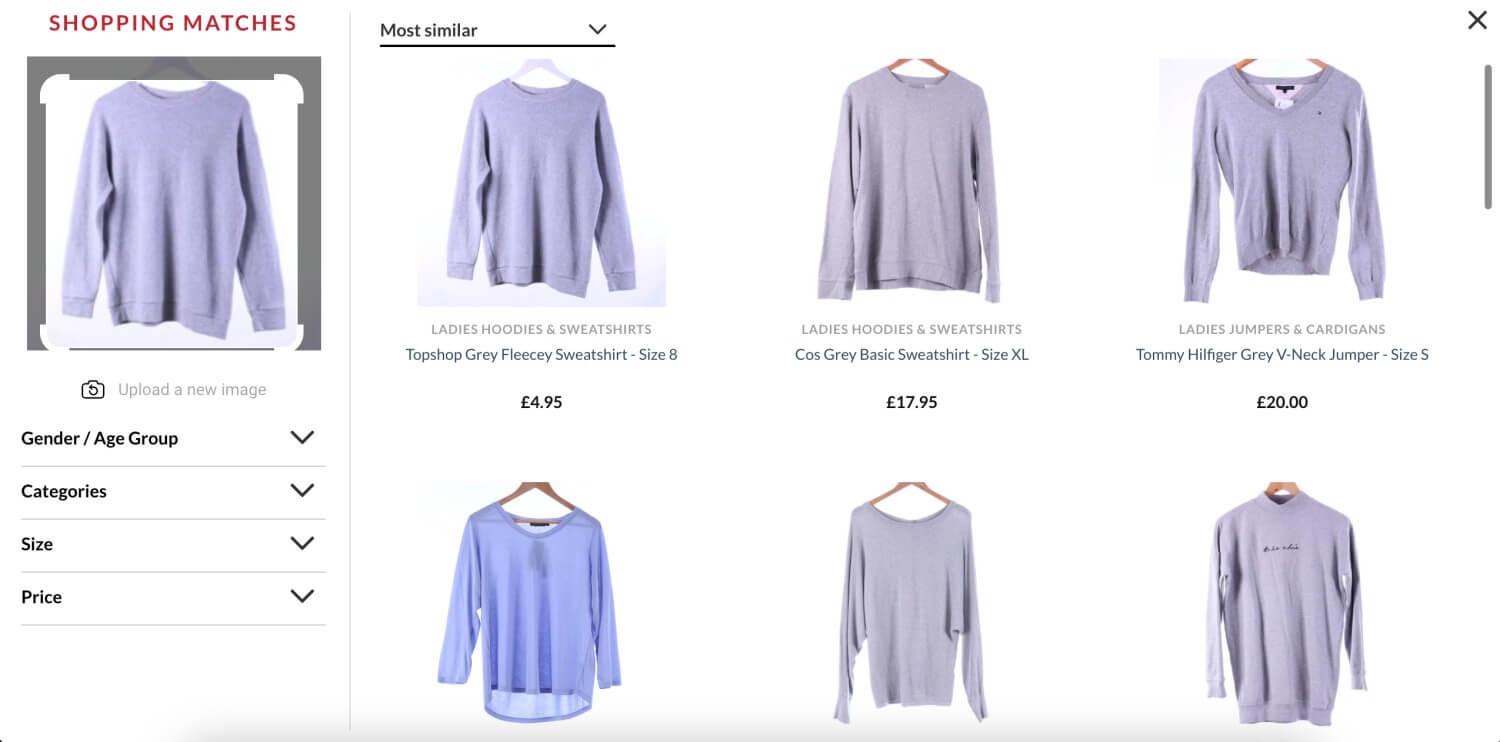The world we live in is made up of images. Considering how visual humans are, and how much visual data we process each day, it makes sense that businesses today are exploring how visual AI advancements can create better experiences for their customers while also supporting operational efficiency and optimization.
This post will break down the exciting world of visual AI, its evolution, and how it’s being applied across industries, with a focus on retail and eCommerce.

Visual AI: Background & Current Applications
Visual artificial intelligence is a computer science discipline that trains machines to make sense of images and visual data the same way people do. With the help of visual AI, machines don’t just see –they are also able to understand and perceive the meaning behind images in accordance with how the algorithm is trained. For example, they may be able to categorize objects within an image and understand if each object is a table, a chair, or a lamp, just as a person would, by comparing them to images they have previously “seen.” Visual AI is also the technology that enables facial recognition, visual search, QR code scanning, and more.
A growing market
As more businesses use visual AI applications to optimize processes and improve user experience, the field is expected to grow dramatically. In fact, the value of the AI image recognition market in 2020 was $1.7 billion and is expected to reach $5.2 billion by 2026, at a compound annual growth rate (CAGR) of 24.82%.
Eirik Thorsnes at UNI Research explained that “There has been a tremendous development in recent years, and we are now surpassing the human level in terms of image recognition and analysis. Computers never get tired of looking at near-identical images and may be capable of noticing even the tiniest nuances that we humans cannot see. In addition, as it gets easier to analyze large volumes of images and video, many processes in society can be improved and optimized.”
Visual AI’s various industry applications
The advancement of visual AI has enabled the development of new technologies for a variety of industries, including healthcare, security, sports and entertainment, manufacturing, automotive, retail (more on that later), and more. Here’s a look at the innovation we’re already seeing:
- Healthcare: The impact of visual AI on healthcare is extensive. It is applied in medical imaging analysis, report automation, and to enable more efficient and accurate diagnosis.
- Security and surveillance: The growth of surveillance cameras has outpaced the ability of humans to monitor them. Visual AI helps with crowd and behavior analysis, people and object tracking, the identification of disorderly behavior, and more.
- Sports and entertainment: In the world of sports, teams and coaches use visual AI to analyze the performance of players, create three-dimensional simulations for refereeing, and gauge fan mood and engagement.
- Manufacturing: Visual AI is one of the technologies supporting Industry 4.0 with applications such as package inspection, predictive maintenance, robotics, and defect detection and reduction.
- Automotive: In addition to autonomous and semi-autonomous driving, other uses of visual AI in the automotive industry include driver behavior analysis, traffic management, as well as safety and preventive measures, such as the detection of pedestrians.
- Consumer electronics: Apple’s face detection and augmented reality, which enable users to unlock phones and create personalized emojis, are everyday examples of visual AI in the consumer electronics vertical. Similar use cases can be found on social media platforms, like TikTok and Instagram.

How Visual AI for Retail Works
Retail is constantly transforming in order to keep pace with consumers’ changing needs. Both in-store and online, brands and retailers have to consistently improve the customer experience and simultaneously, reduce inefficiencies and lower costs. AI in general, and visual AI in particular, enable many solutions for these challenges.
In fact, Gartner predicted that the global business value derived from AI by 2022 will reach $3.9 trillion, and Capgemini estimated that retailers will spend about $7.3 billion on AI by the same year.
Visual AI for Retail: Use Cases
With visual AI, brands and retailers can enable systems to optimize the customer experience, merchandising, inventory management, business insights and decision-making, and more. Here’s a breakdown of how brands are already using this technology:
- Inventory and demand forecasting: For retailers with thousands of SKUs, inventory tagging can be very manual and inconsistent. Visual AI can clean up catalogues and make the metadata that goes along with products more consistent. Other related applications include stock replenishment, sales analysis, and shelf-scanning robots like the ones deployed by Walmart.
- Cashierless stores: Stores such as Amazon Go and Hema (Alibaba) use visual AI to not only “read” products for checkout but also to detect and track customer movements. This can enable retailers to provide quick and convenient in-store checkout.
- Facial recognition: Visual AI can help brands and retailers identify loyal customers and personalize their in-store experiences based on previous and present shopping behaviors. Facial recognition can also improve security and fraud detection.
- Merchandising: In brick-and-mortar stores, visual AI can analyze behavior patterns to improve store and product layouts, and online it can be used to expedite product tagging as well as make merchandising tactics as effective as possible.
- Visual search: Shoppers’ ability to search is often limited by their knowledge of product terminology. Visual AI can provide them with the ability to find any item online or in-store by uploading an image to find visually similar items.
- Personalization: Visual AI enables retailers to take personalization to the next level by combining image data with other customer data from multiple sessions as well as real-time browsing information. This allows brands and retailers to recommend relevant products down to the finest visual details.

The Evolution of Visual AI in Retail and eCommerce
According to the Intent Lab, 59% of consumers trust and prefer visual information over text. When it comes to retail, images are essential for setting the mood, building confidence in products, and fostering connections with consumers. The importance of visual information drives brands and retailers to push the boundaries of visual AI, so every new development leads to more sophisticated applications in retail and eCommerce.
Before we dive in, it’s important to note that n all industries, but especially in retail, the success of any visual-AI-based technology depends deeply on the speed with which the technology can process images and the accuracy with which it “reads” them. By hitting these two critical targets, brands and retailers are able to significantly improve the shopping experience.
Product matching with camera search
Visual AI can form the basis for both image and text search by identifying the visual attributes within a retailer’s entire inventory and automatically assigning them “deep tags,” or metadata that augments and standardizes each product’s original tags.
Because the technology can identify the most minute details in any image, that also means that if a shopper searches via image, the similar items it finds within a retailer’s inventory will bear a striking similarity to the item in the original photo. As mentioned above, the degree of accuracy in matching these visual attributes in search results is the “make-or-break” for visual search.
Related suggestions and similar images
Building on the advancements in image-to-image search, the applications of visual AI for retail have expanded to include product recommendations, such as carousels that suggest items to complete a fashion look or a room design from a product photo. This is another way to ensure continuous product discovery as shoppers navigate through an eCommerce site.
Another use case is merchandising optimization. For example, creating inspirational galleries on an eCommerce homepage based on selected product attributes. With visual AI, the data extracted from images ensures that the products selected for any thematic gallery are deeply relevant. 
Real-time intelligence and context
Visual-AI-based metatag data is unlocking new personalization opportunities for brands and retailers. The granular visual data means that recommendation engines can track in-session behavior down to the cut of a coat that a shopper has viewed or the style of a sleeve they’ve added to cart, ensuring that every product recommendation is hyper-relevant.
How Visual AI Impacts Customer Experience
Today, the battleground for retailers is customer experience — product and price are too easy to replicate, but experience is an intangible where brands can truly differentiate themselves.
This is especially relevant for eCommerce now, as compelled by the effects of the pandemic, many consumers have become digital-first, and their additional experience online has made them more discerning. Value, convenience, and availability are now the top influences on shopper decision-making. These new expectations, McKinsey & Co. found, are set to remain post-COVID, as reported by 65% of consumers.
3 ways visual AI boosts the customer experience
Now that we better understand what shoppers are looking for, how can visual AI deliver value, convenience, and availability throughout the customer experience?
1. Improving product discovery and providing ongoing inspiration
Digital shoppers don’t have store associates to guide them through your website and find the products that they’re looking for. Visual AI is the closest-to-human foundation for a useful set of product discovery tools that understand shopper tastes.
By providing avenues for product discovery like camera search, smart merchandising galleries, and product recommendations, shoppers feel catered to the way they would in a store with an experienced sales associate. When brands provide an intuitive user interface for these on-site tools, shoppers can enjoy continuous product discovery, uncovering new items that inspire them throughout their journey. The result is a sense that the brand or retailer really “gets” them and their style or needs.
2. Leading customers from search to purchase without friction (or frustration)
One of the frustrations that customers face when shopping online is identifying not only the name of a product but also its brand, style, and other details that make it unique. This is particularly true when customers get inspiration from what they see on social media or in real life, but don’t know how to translate what they have in mind into words.
Visual AI can solve these challenges. Camera search allows customers to simply upload a photo or screenshot of an item they’re interested in and to find similar products. The same technology can be applied in other use cases — for example, letting shoppers click through on any product image they like to find all similar items in stock.

3. Building a strong foundation for omnichannel retail
Finally, visual AI can help brands and retailers offer truly consistent, seamless, and personalized shopping experiences regardless of the channel customers choose to use—online or offline.
With visual AI, retailers can gather search and shopping data, and turn it into actionable insights to inform omnichannel strategies, ensuring that both physical and digital recommendations are driven by previous and real-time visits and purchases. Using image data to automatically tag products makes this cost-effective and accessible. In-store, smart tablets and mirrors can further enhance the experience, creating a personalized fitting room experience.
As retail reopens, integrating the positive online experiences shoppers enjoy within physical stores will be a crucial way to increase brand affinity and promote omnichannel purchasing.
The Future of Visual AI for Retail
Visual AI is still a young technology, and its retail applications all the more so. Still, it’s already evident that it’s the foundation for an improved end-to-end customer experience. It connects customers to the products they love without friction, creating valuable, convenient, and accessible buying experiences worth remembering and coming back for. The brands that are first to begin using visual AI to craft experiences that win over their shoppers will have a leg up on the competition.